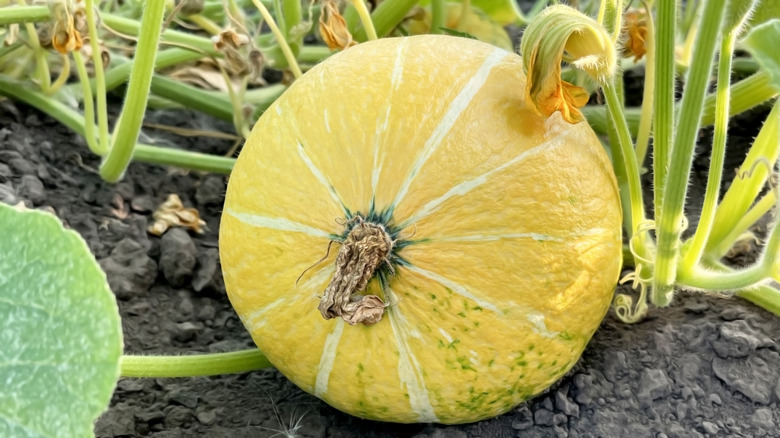Yellow Pumpkins On Porches Have A Touching Purpose: Here's What They Mean
If you plan to welcome trick-or-treaters to your door this year, you might want to consider swapping one of your usual orange pumpkins — fake or grown from pumpkin seeds — for something a little brighter. Yellow pumpkins have been popping up all over in the past couple years, and while you may have thought it was just a design fad, there is actually a deeper (and more important) meaning. The yellow pumpkin trend was started by mom Laura Slatter to raise the public's awareness about apraxia of speech (AOS). Slatter's son was affected by the condition, and the idea behind the yellow pumpkins was to make trick-or-treating more accessible for kids with special needs.
Since AOS is a condition that affects one's ability to speak with ease and clarity, placing a yellow pumpkin on your porch signifies to kids and parents that they won't expect a verbal cue in order to get candy. Similarly, kids with yellow bags or yellow Halloween buckets alert the candy givers of the condition, so they can help identify kids with disabilities and provide a pleasant and inclusive experience without confusion.
The idea for the Yellow Pumpkin Parade project was inspired by the Teal Pumpkin Project — a similar concept from the Food Allergy Research & Education organization, which wants to remind treat givers and chaperones that some kids have severe food allergies and may not be able to eat candy you're giving away. Slatter's drive to create the movement was due to her son being pressed at the door to correctly say "trick or treat" — something he was unable to do — which left him in tears and too embarrassed to approach another house that night.
Do any other colored pumpkins have hidden meaning?
Yellow and teal aren't the only pumpkin colors with a hidden meaning. In fact, there is a whole rainbow to choose from. Purple stands for epilepsy awareness, pink for breast cancer awareness, blue for autism awareness, red for Mothers Against Drunk Driving (MADD), and white for infertility and infant loss. While some of these are simply for raising awareness and showing support, others—like blue, teal, and yellow serve as markers for kids and families that the house is welcoming to children with their needs.
When it comes to actually handing out candy, the best rule of thumb is to treat kids with kindness, and reserve expectations — because every kid should be able to have a great night regardless of their abilities. If you are looking for some ways to make the experience more inclusive, consider more sensory-friendly lights and sound effects, as well as sitting outside so you can go to a child with ambulatory challenges. Whether you choose chic Halloween decor or a more kitschy style, let's make this Halloween fun and inclusive for all, and keep the haunting to creepy decor.

